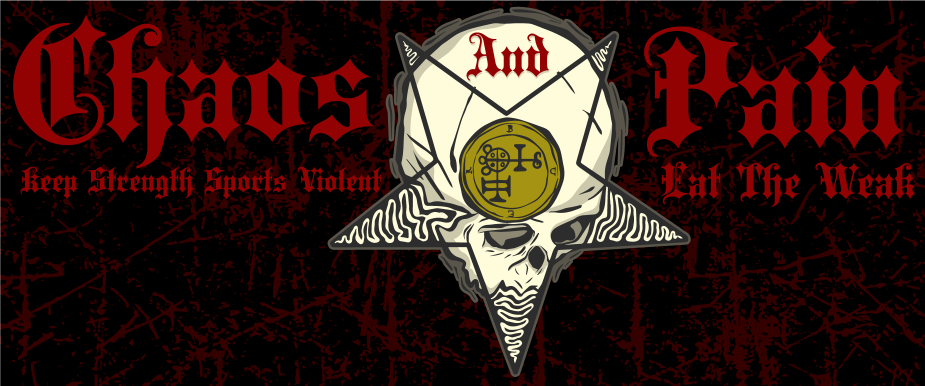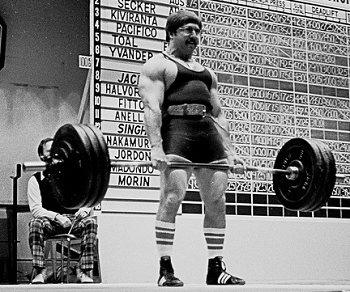October 1998, fresh off a solid bout of dysentary contracted in China during a summer of study abroad, I'm finally back up to a reasonable bodyweight and am invited by a badass broad I'd only just met to join her at her friend's house to watch UFC Brazil. Tank Abbott was, at the time, the living embodiment of Godzilla's unstoppable juggernaut persona mixed with a white trash bar brawler's total lack of respect for his opponent and utter disregard for sportsmanship. He was, to a college-age asshole, the greatest fighter of all time- Mike Tyson with less rape and more humor. Thus, in honor of that fat-assed, drunken, 600 lbs bencher, my buddies and I blasted bench, then headed to Hooters to drink in the bloody spectacularity that was Tank.
There we sat, soaking up the bloodsoaked goodness of UFC Brazil, when the pre-fight promos for Wanderlei Silva vs. Vitor Belfort started. We'd not heard of either guy, but the intro made it look like the fight of the night, and we were not disappointed. Wanderlei "The Axe Murderer" Silva was billed as the only fighter in history who earned his nickname and didn't give it to himself. After seeing the fight, many years later, that earned him that moniker, it was no wonder the announcers thought this fight was going to be insane- Wanderlei had a reputation for nearly killing himself in an effort to mangle his opponents, and did so with about as much regard for his phsyical condition as Honey Boo-Boo has for her own. You have to admire that kind of ferocity in a fighter, and the UFC's announcers definitely did... at least until Vitor Belfort beat Wandy half into a coma in what was one of the fast beatdowns in mma history and what will go down in history as the most effective modified straight blast in history.
Clearly, this was not an auspicious start for Silva, who later earned a reputation for being an utter fucking beast in the Japanese promotion Pride but struggling whenever his soccer kicks and stomps were taken away. Silva, however, continued to forge ahead, pulling down the most wins in PRIDE history, the longest undefeated streak in PRIDE history, the most knockouts in PRIDE history, the Sports Illustrated 2004 Knockout of the Decade, and a 35–12–1 record in a fighting career that has spanned almost 20 years, three weightclasses, and just about the entirety of modern mixed martial arts. Additionally, Silva's founded his own fight team, opened a free mma gym in Paraiba, Brazil, and intends to run for Brazilian Congress in 2014.
That about sums up the awesome that has been Silva's career.
Two factors have played heavily into The Axe Murder's success- psychotic, unrestrained, bloody foam-at-the-lips aggression, and brute strength. As to the former, you need look no further than Silva's fights- they're almost invariably ten seconds of staring, followed by Silva getting punched and then losing his fucking mind in an effort to end the offending puncher. Silva's so aggressive taht I used to joke he'd have to be caged backstage to prevent brawls from breaking out in the locker room, and the Japanese treated Silva much in the way they would have a prized rabid fighting dog or Musashi the famed, unwashed hobo of a Japanese swordsman- they feared him just enough to throw an endless supply of tiny fearless Japanese into the ring with him to prove their mettle by nearly dying at the hands of an indomitable foe.
One pundit from Bleacher Report Characterized Silva thusly,
"In a sport filled to the brim with violent and scary men, Silva is the scariest. He has an aura of violence. He doesn't just commit unspeakably monstrous acts in the ring—he exudes malice"(Snowden).That's the kind of guy Wanderlei Silva is- not only does he give zero fucks, but he intends you to reduce his opposition to a state in which they're incapable of giving a fuck about anything ever again. In case you're new to mma and think Wandy is overrated, you need watch nothing more than Wandy's fight with former IFC, Superbrawl, and UFC fixture Eugene Jackson, whom Wandy dismantled with extreme prejudice in short order under very loose Brazilian vale tudo rules.
Beyond Silva's aggression is his strength, which is legendary. According to UFC legend Tito Ortiz, Silva is one of the two hardest punchers he's ever faced, and given that Ortiz has a head so large that he'd not look our of place standing on a grassy knoll in Easter Island, that's high praise. A quick glance at any of Silva's fights shows he manhandles even opponents who outweigh him considerably, like Mark Hunt, and a look at his record is a written testament to Silva's strength- twenty seven of his thirty-five wins are by way of knockout.
Though you'll see much is made these days of circuit training with elite fighters and the "fact" that these fighters eschew traditional strength training methods, that's simply not the case- Matt Hughes, who built a career on his strength, relied heavily on bodypart training and heavy weights (Hughes); George St. Pierre does heavy snatches and incline bench pressing as regular parts of his training (Bornstein); low-kick knockout artist and overall monster Pat Barry trains heavier than most powerlifters; and the guy who KO'd Barry in under a minute, Shawn Jordan, who benches 610lbs and power cleans 440lbs. Despite what the 135 lb "experts" on the forums might assert, brutal power comes from brutal training, and Wanderlei Silva is no exception. Though Silva's career has spanned about as much time as most of the readers of this article have been alive, his methods have hardly been stagnant. Instead, Silva's been on the cutting edge of training methods for years, mixing unorthodox and new styles of training in with the tried and true.
When you're looking at Wandy's much ballyhooed conditioning routine of late, you must bear in mind one thing- he's doing this routine as a circuit with his nose taped shut, wearing a weighted vest, and breathing through a snorkel. This training style, called hipoxia, is the latest training method in experimentation under Wandy's strength and conditioning coach, Rafael Alejarra, and complements his regular strength training. Not unlike Sean Sherk's training, Wandy's conditioning consists of heavy-bag body slams, incline sprinting, battling ropes, light olympic lifting, and the modified viking presses you'll see American football linemen doing, in addition to other, even less fun drills and lifts... all while wearing that snorkel and vest with his nose shut. After watching the video, I concluded I'd be dead within minutes of cardiac arrest, and thus forgave Wandy what on the surface seemed like baby weights.
Circuits 1 and 2 should be done twice in a row, and circuit 3 should be completed three times. The entire thing should take no more than 25 minutes, and should be be conducted four times a week with a 45 pound vest, one's nose taped, and the snorkel on one's face. The point here is not simply conditioning- it's to get an athlete to tolerate massive amounts of lactic acid in the blood. Wandy's trainer has tested this extensively and has presented the results to the Brazilian Masters of Exercise Biochemistry board to demonstrate the extreme increase in the conditioning of both the aerobic and anaerobic systems.
Circuit 1
- Clean and Jerk: 8 Reps x 110 lbs
- 1 Meter Jump: AMRAP x 30 seconds
- Punching Machine: 15 Reps x 55 lbs
- Run 3 Flights of Stairs
Rest for 40 seconds between circuits
Circuit 2
- Pull Downs: 12 Reps x 200 lbs
- Resistance Bands: 4 Wrestling Shots
- Lateral Box Plyometric Push Offs: AMRAP x 30 seconds
- Run 3 Flight of Stairs
Rest for 40 seconds between circuits
Circuit 3
- Clean and Jerk: 8 Reps x 110 pounds
- Pulldowns: 12 Reps x 200lbs
- 5 Sprawl Drills
- Run 3 Flights of Stairs
Rest for 40 seconds between circuits
In summary, Wanderlei Silva is one of the baddest motherfuckers to ever walk the Earth- aside from being one of the hardest punchers on the planet, he will headbutt an opponent until his face is falling off simply because his opponent's head still seems to be attached, will happily soccer kick a small Japanese man in the face for a paycheck, employs training techniques that border on medieval torture mixed with auto-erotic asphyxiation, and has the single greatest pre-fight staredown in the history of pugilism. If that isn't inspiration for all of us to harden the fuck up, I don't know what is. Go wreck something.
Sources:
Bornstein, Adam and Abby Lerner. Georges St. Pierre's UFC Workout. Men's Health. Web. 29 Apr 2014. http://www.menshealth.com/celebrity-fitness/slideshows/georges-st-pierres-ufc-workout-slideshow
Hughes, Matt. Training. Matt Hughes. Web. 29 Apr 2014. http://www.matt-hughes.com/training.html
Jon, Mikhail. Wanderlei Silva's extreme conditioning workout. Mixedmartialarts.com. 27 Oct 2009. Web. 9 Apr 2014. http://www.mixedmartialarts.com/?go=blogs.Detail&gid=20846
Mack J, Stojsih S, Sherman D, Dau N, Bir C. Amateur boxer biomechanics and punch force. Int Con Biomechanics Sport. 2010, (28): 1-4.
Rousseau, Robert. Biography and Profile of Wanderlei Silva. About.com. Web. 29 Apr 2014.
Top five MMA training routines. Joe.ie. 2011. Web. 9 Apr 2014. http://www.joe.ie/health/exercise-of-the-week/top-five-mma-training-routines/
Wanderlei Silva training MMA. Pro Fighter Workouts. Web. 9 Apr 2014. http://www.profighterworkouts.com/wanderlei



.jpg)















































